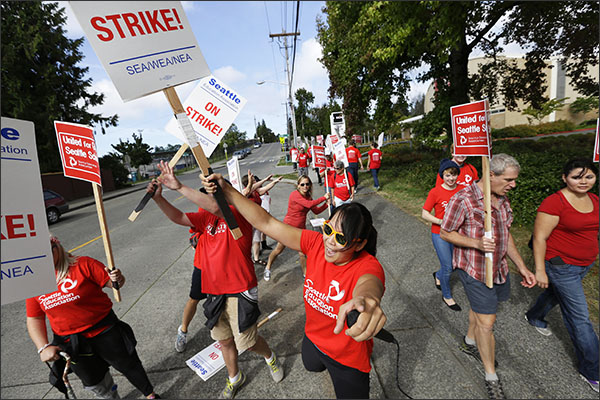This morning KUOW radio reported the Seattle teachers union, the SEA, will vote this Saturday on whether to join a possible bus drivers strike against the school district. Membership in the SEA union is mandatory. Union executives say they will have any teacher who does not make a regular monthly payment to them fired.
SEA President Phyllis Campano says students would not be hurt by the planned strike action because teachers would close schools on a Wednesday. She is referring to the policy under which Seattle students no longer get five full days of instruction a week. Instead, every Wednesday students are sent home early.
How did students end up with shorter learning days? At the June 7, 2017 Seattle School Board meeting, the board accepted a union request to shorten the school calendar and cut instruction on Wednesdays. Here is how this policy is described on the Seattle Public School website:
“The school calendar is negotiated between Seattle Education Association and the district. The Seattle School Board adopted the 2017-18 school calendar at the June 7, 2017, board meeting.
Students are released 75 minutes early every Wednesday, except for the first day of school. This is to support improved teacher collaboration and student academic performance."
Oddly, the union says student academic performance will improve if students spend less time with teachers.
In other words, the Seattle Public Schools adopted a school calendar which reduces instruction for children on Wednesdays. Now we learn that union president Campano plans to use the short-instruction day as a strike day.
Twenty-seven unions operate in the Seattle Public Schools. Membership in each one of them is mandatory. At any time, executives at any one of these unions may call upon SEA to support a strike, again closing schools on a Wednesday. The arrangement makes teacher strikes in Seattle more likely.
This helps explain why federal data shows a child in Washington state is more likely to face school closures and reduced educational opportunities caused by union action than children in any other state.
Teachers strikes, bus driver strikes, and other fights among adults should not be used to disrupt the education of children. This controversy is another example, in a long list, of how union collective bargaining and mandatory paid union membership harms the education of children.




